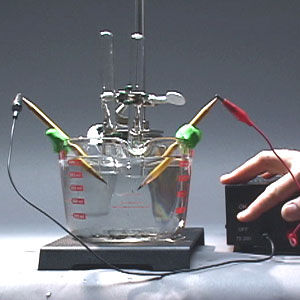Join us for conversations that inspire, recognize, and encourage innovation and best practices in the education profession.
Available on Apple Podcasts, Spotify, Google Podcasts, and more.
During this session, you will have an opportunity to build understandings to help you:

Electrolysis
Where does the weight go when we “lose weight”? What happens when iron rusts? Why are exploding stars able to turn other elements into gold when the alchemists were not? In this session, we will extend and refine the particle model by taking a closer look at the particles—atoms and molecules—and will discover how the law of conservation of matter applies to chemical changes.
We begin our investigation into the nature of particles by observing that they have distinct sizes and shapes. Is this the explanation for the “missing volume” of the shaken mixture of water and alcohol in Session 3? Our hosts introduce the idea of chemical changes and show an example of one way that they are distinguished from physical changes.
Throughout this session, we visit Rebecca Cituk’s classroom in Portsmouth, Rhode Island, where we listen as her sixth graders discuss the differences between chemical changes and physical changes and elements and compounds, and perform a classic experiment to see if matter is conserved in a chemical change. We return to the Science Studio where the interviewer uses a different approach—manipulatives—to help Cameron, a fifth-grade student, explore a chemical change in which two clear liquids combine to form an opaque white solid. Both of these instances raise the following question: What happens on the particle level that makes chemical changes different from physical changes?
We then take a step back as science historian Mimi Kim takes us on a historical journey through the development of the modern science of chemistry, beginning with Étienne Geoffroy’s “affinity table” in 1718. Along the way, we revisit some of the experiments of Lavoisier and Boyle that broke substances down to their simplest components—elements—and provided the first evidence for the law of conservation of matter.
Our hosts pick up the journey, noting the contributions of Proust, Dalton, Avogadro, and Sir William Robert Grove, whose electrolysis of water experiment they recreate as a real-world example of the law of fixed proportions. We conclude the journey with Mendeleev’s organization of the elements into the periodic table and ask astrophysicist Dr. Robert Kirshner “Where did the elements come from?”